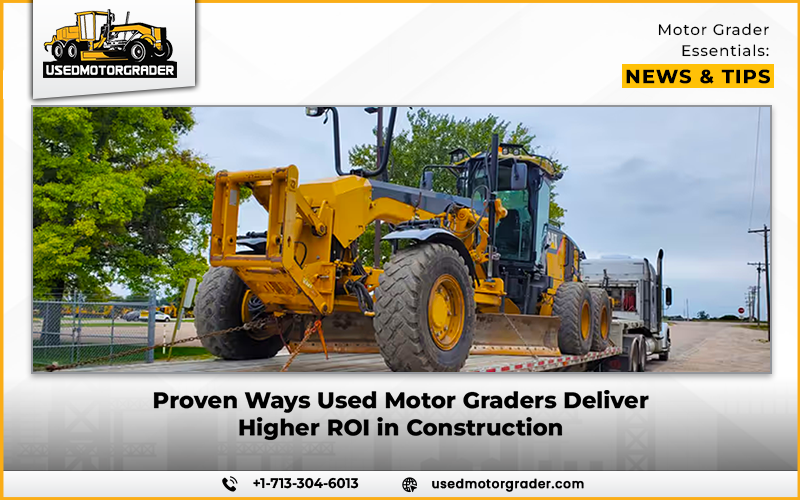Smarter Investments In Equipment
For construction firms and earthmoving contractors, return on investment is the driving force for nearly any buying decision. While new machines attract attention, the economics tend to point in a different direction. Used motor graders, carefully selected, can deliver the same essential performance in grading, shaping, and finishing operations with a lot less capital required. Instead of tying up resources in brand-new equipment, companies can put to work a reliable used grader and invest the savings into other priorities that help keep projects moving.
Lower Purchase Price, More Savings
The first and most obvious one is cost. Used motor graders can be picked up for a fraction of the cost of a new one. That immediately gives you cash for fuel, payroll, or to bid on more work. Just as important, depreciation has had the biggest bite. New machines lose value rapidly in the first years of service, but the value of a well-selected used model is more constant. From a financial standpoint, this makes a used grader not only cheaper to buy but also makes it easier to justify it on the balance sheet over time.
Reduced Ownership Costs
Initial savings are part of the story. Operating costs related to equipment value, such as insurance premiums and property taxes, are lower with used machines. These recurring expenses can silently chomp on the profits if not managed well. By using a lower-cost asset to start with, companies lessen the impact of these fixed costs and lower the breakeven point. In practical terms, it means that the grader may require fewer billable hours for the firm to achieve profitability, which is particularly important to smaller contractors or firms that work on seasonal loads.
Proven Performance That Lasts
It’s a mistake to think that because of age, equipment is automatically less capable. Designers have built motor graders around the same core functions for decades, and the fundamentals of earthmoving remain unchanged. Contractors can still use a machine ten or even fifteen years old for sub-grade preparation, slope creation, and finish work with precision. In fact, many operators are fond of the simplicity of slightly older models, which often provide the same results with none of the complexity of extra electronics. Proper maintenance keeps the grader’s capabilities totally intact.
Built To Last, Maintained with Ease
Durability is a component of appeal. Manufacturers design motor graders for heavy workloads and long service lives, and sellers often place carefully maintained machines on the used market long before they reach the end of their useful life. Another benefit is the good aftermarket support. Replacement parts for popular models are widely available and are usually cheaper than the parts for the latest machines. That makes it easier to plan maintenance and to keep downtime in check. For contractors, this predictability means job-site reliability directly.
Strategic Fleet Optimization
Adding a motor grader to the fleet is not only about capacity. It’s about maximizing equipment performance where the equipment is used. Used motor graders are a way to get dedicated grading power without the financial commitment of a new unit. Dozers, loaders, and other machines focus on the jobs they were built for instead of filling in as graders. The result is more efficient use of resources, improved productivity, and less unnecessary wear across the fleet.
More Than Just Grading
The value of a grader is also due to its versatility. While grading is its primary task, attachments add to its role on the job site. With the appropriate set-up, operators can use it for snow removal during winter, loosening soil with a scarifier, or finishing compaction with special tools. This adaptability makes it so one machine can be productive all year round, generating revenue in a variety of projects and seasons. In markets that are characterized by seasonal work, this type of flexibility matters especially.
Reducing Financial Risk
Another strength of the used equipment approach is risk management. Because the purchase price is less, the financial exposure is less. If market conditions change or workloads decrease, sellers can often resell a used grader with very little loss in value. For contractors that work in competitive or uncertain markets, that flexibility is important. It takes the pressure off long-term financing commitments and enables businesses to change equipment strategy faster.
The Human Factor: Operator Familiarity
There is also a practical, people-oriented benefit. Many experienced operators are more comfortable with earlier models based on simple controls as opposed to sophisticated electronic systems. This familiarity helps cut down on training time and helps crews get productive more quickly. For companies that depend on skilled operators, keeping your operators comfortable and efficient on the job is just as valuable as the mechanical abilities of the machine.
A Smart Long-Term Choice
Choosing a used motor grader is less compromise and more business sense. This provides clear savings and lower ongoing costs, and reliable performance without tying up critical capital. Manufacturers design these machines to last, support them with robust parts networks, and make them versatile enough to contribute to several kinds of projects. For contractors interested in stable growth, predictable costs, and consistent performance, a well-chosen used grader is more than a machine. It’s a tried and tested, long-term asset that continues to earn its place on the job site.


